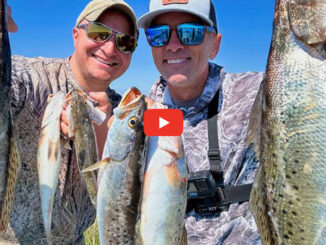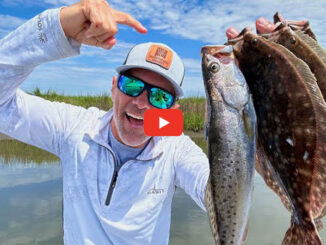Cold fronts often wreak havoc on speckled trout anglers that target the marshes of South Louisiana. Whether it’s the dramatic temperature swings or rising barometric pressure, these troughs are often enough to force anglers to hit the pause button on catching specks and opt for the fireplace and a football game instead.
That’s not the case with Danny Hunter of New Orleans Best Charters.
“Mid-winter fishing can be a challenge but I’ve found that the more I fish a certain situation, like fishing after a front, the better I get,” he said.
Hunter has been fishing the saltwater marsh between Delacroix and Lake Borgne since before he can remember.
“I have old pictures of myself catching speckled trout and I have absolutely no recollection of those fish,” Hunter said.
It’s those moments that help him simplify what most fishermen overthink.
“Think back to when you were a kid,” he said. “You didn’t worry about these cold fronts! Heck, you didn’t even know a front was coming. You just went fishing, right? Well, I try to keep that mindset even today.”
After becoming a charter captain, Hunter has admittedly fished more post-frontal days because he believes it helps him become a better fisherman.
“If I pass over those days and don’t go fishing, how am I going to learn?” he said. “To me, that’s what fishing is all about — the challenge that each day brings.”
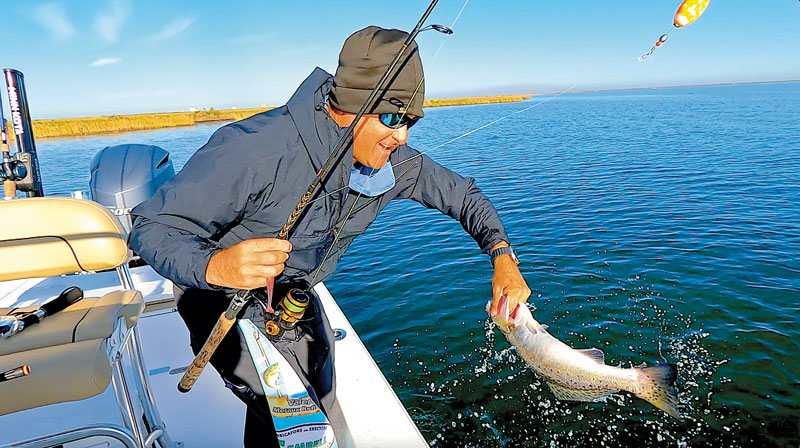
Hunter’s setup
Hunter is an admitted cork fiend and uses them all year.
His go-to setup is a 7 foot moderate fast action rod lined with 20-pound Daiwa J-Braid. He rigs a Finger Lure made by Blue Collar Baits under an Undertaker Cork. However, when he’s fishing after a cold front, Hunter changes things up a bit.
“If I’m jigging the bottom after a cold front, I like to throw my Shimano bait caster on my Matrix rod,” he said. “I use a 20-pound fluorocarbon leader and depending on how strong the current is I’ll tie on a 1/8, 1/4, 3/8, or a ½-ounce Deathgrip jig head.”
If the fish are suspended off the bottom, Hunter switches over to using a drop-shot rig with a 1-ounce bank sinker. He rigs a Finger Lure onto the hook that is tied about one foot off of the bottom.
Hide from the wind
Cold fronts usually bring strong winds out of the north. It’s not uncommon for the winds to be upwards of 20 mph on days that precede a trough. On days like this, Hunter uses the land to his advantage.
“When the wind is blowing hard out of the north, I try to fish areas that are protected by land,” he said. “I’ve found that the water is usually cleaner and much calmer.”
After finding calmer water, Hunter uses his side scan, down scan, and sonar to find bait.
“If I can find bait in those protected areas it’s usually on,” he said. “I’ll hit the spot-lock and see if there are any trout under the bait.”
Not only does land offer protected water, but the winds out of the north can also serve to push water out of the marsh on days with little to no tidal range.
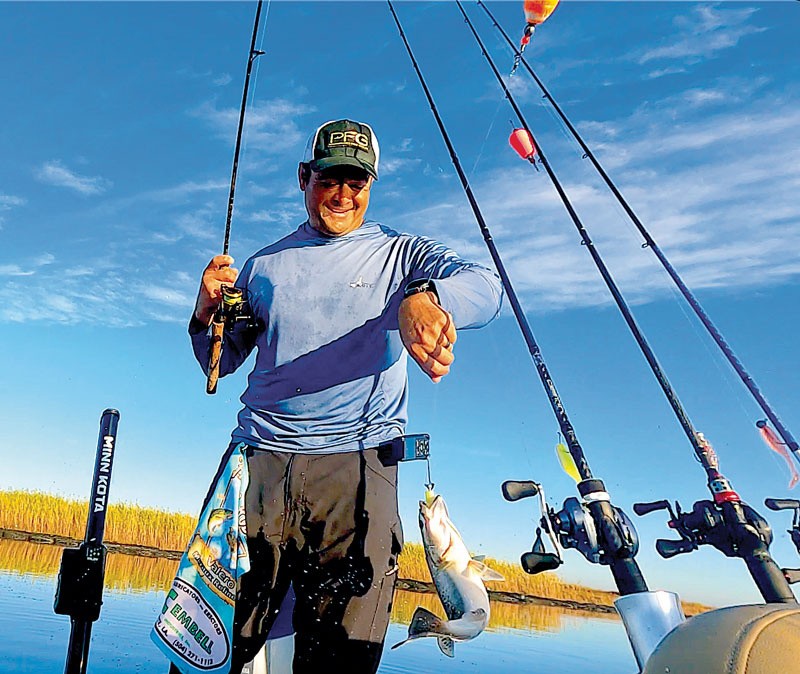
Go deeper
Cold fronts can often bring about plummeting temperatures. Hunter said cold water temperatures help him eliminate certain areas to fish.
“I’ll check my electronics and if I see the surface temperature is 50 degrees or below, there’s a pretty good chance I won’t be stopping there to try for speckled trout,” he said.
When fishing on days when it’s hard to find water in the upper 50’s, Hunter recommends finding deep water.
“On the rare chance that I’m fishing on days when the daytime high is forecasted to be in the 40’s, I’ll head straight to the deepest holes that I know of,” he said.
It’s common for anglers to target flats during the winter months because of the sun’s ability to warm up the shallow water and attract trout, however, Hunter said he prefers to fish deep water until the barometric pressure stabilizes, which happens a few days after the trough passes.
Post-frontal hotspots
A popular area that garners a lot of attention during the winter months are the MRGO and ICW. The deep water in these channels is a custom fit for speckled trout looking to escape the cold shallow water and barometric pressure swings. Hunter said there’s a reason why you see so many boats in this area this month.
“Trout and redfish like to stack up along them when it gets cold,” Hunter said. “Some people fish that area with a sliding cork but I like jigging the bottom with a Finger Lure on a ¼-ounce or 3/8-ounce jig head.”
Hunter uses his side-scan electronics alongside the rocks and looks for bait. Then when he finds baitfish, he hits the spot lock and casts all around the boat.
“I’ve found that they aren’t always stacked up on the rocks,” he said. “Sometimes they’re 30 feet off the rocks in 25 feet of water. You also have to try different things to figure out how they want it presented. Some successful techniques I’ve used have been letting the bait sit on the bottom, popping the bait up every couple of seconds, and slowly reeling the bait along the bottom.”
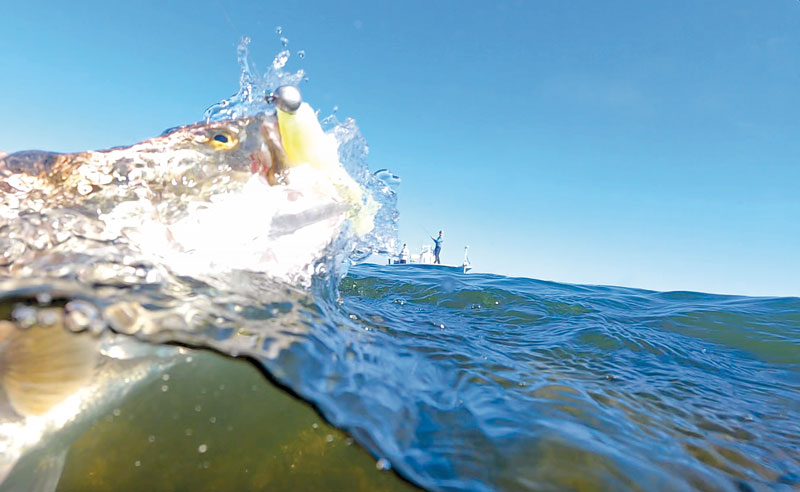
Look for loons
While electronics play a major part in helping to find fish in cold weather, Hunter also uses birds to inform him as to where the baitfish is.
“There are loons all over the area right now,” he said.
While most species of loon inhabit areas of the country to the north and even the Arctic, the Common Loon does venture south and can be spotted diving for food in the cleaner, deeper canals in South Louisiana.
“I like to keep tabs on where these diving birds are congregating,” he said. “When I see a few going underwater in the same spot, I’ll move over to where they are.”
Hunter said there are two reasons why it’s important to fish near these birds.
“Those loons aren’t diving for fun, they’re looking for food down there,” he said. “It can be wounded shad that predator fish are beating up on or they can be diving right into a ball of baitfish. Also, where there are loons, there’s clean water. I hardly ever seen loons diving in murky water.”
Hunter said this month the loons are all over and shouldn’t be overlooked when trying to hone in on cold water specks.
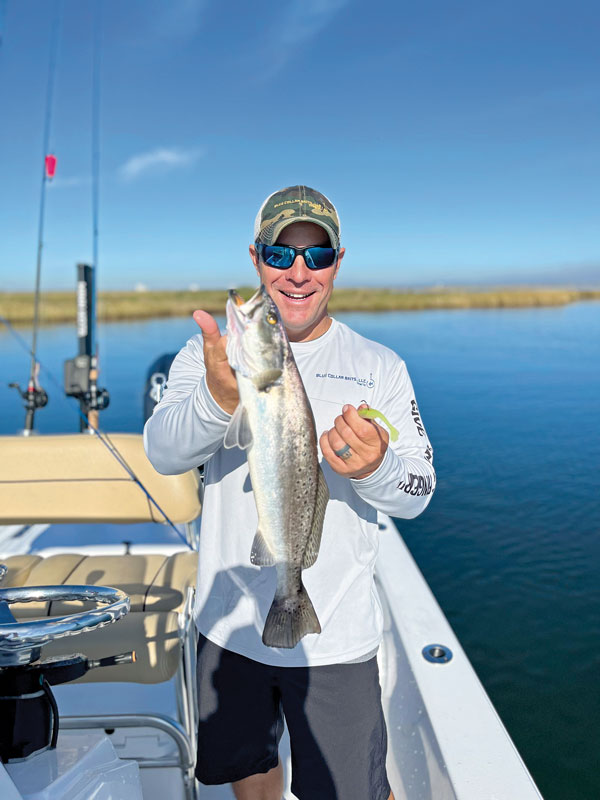
A trip to remember
This month the trout are stacked up once again and Hunter is catching big specks as the weather gets colder. Big trout are especially important considering Louisiana’s new trout regulations. If you aren’t familiar with those, get familiar.
Hunter said everything is setting up for an amazing month of fishing in the MRGO, much like the one they had last year. Hunter recalls two back-to-back trips he and his son, Danny Jr, made in late December.
“Last year on Dec. 28, Lil D and I went to the rocks in the MRGO right after a front,” Hunter said. “We were fishing about 15 yards off the rocks, throwing Finger Lures in the Night Shift color on ¼-ounce jig heads. We caught over 37 specks with about 30 of them being hammers that measured between 17-20 inches. But the highlight of the day came when my son caught his personal best trout (19 inches) and then followed up with another personal best (20 inches) just 30 minutes later.”
The father and son team headed home with a box full of fish and memories, but Dad wasn’t done. While Hunter wasn’t planning on fishing the next day, he just couldn’t help but make another trip to see if the fish were still there. He put his 24-foot Sportsman Masters 247 bay boat in at Rigolet’s Marina in Slidell and made the run down the ICW.
“I went back to the same spot the next day by myself and caught a limit of hammer specks, and then a limit of slot reds all in the same spot,” Hunter said. “It was an unforgettable two days.”
With just over two months of cold fronts remaining this winter, it’s important to not eliminate these days off of your fishing calendar. While the conditions may be uncomfortable, a day fishing after a cold front can be just as productive as opting to wait for better conditions to make your next trip.
